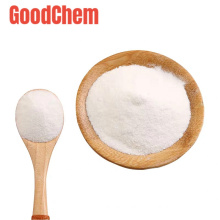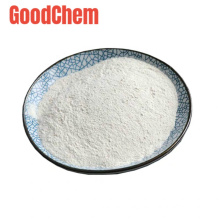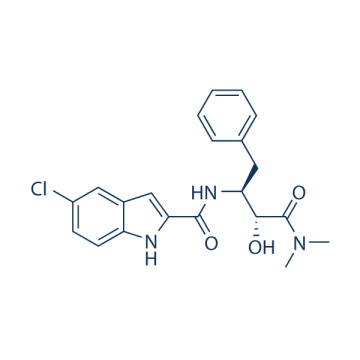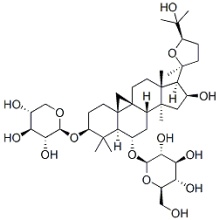.cp_wz table {border-top: 1px solid #ccc; border-left: 1px solid #ccc; } .cp_wz table td {border-right: 1px solid #ccc; borda inferior: 1px sólido #ccc; preenchimento: 5px 0px 0px 5px;} .cp_wz tabela th {border-right: 1px solid #ccc; border-bottom: 1px solid #ccc; preenchimento: 5px 0px 0px 5px;} \ n Peso molecular: \ n 399,87 CP-91149 é um inibidor seletivo de glicogênio fosforilase (GP) com IC50 de 0,13 μM na presença de glicose, 5 a 10 vezes menos potente na ausência de glicose. \ n Atividade biológica
|
Description
|
CP-91149 is a selective glycogen phosphorylase (GP) inhibitor with IC50 of 0.13 μM in the presence of glucose, 5- to 10-fold less potent in the absence of glucose.
|
|
Targets
|
Glycogen phosphorylase (GP) [1]
|
|
IC50
|
0.13 μM
|
|
In vitro
|
CP-91149 displays 200-fold higher inhibitory activity against human liver glycogen phosphorylase a (HLGPa) than caffeine (IC50 = 26 μM). CP-91149 (10-100 μM) inhibits glucagon-stimulated glycogenolysis in isolated rat hepatocytes in a dose-dependent manner, and in primary human hepatocytes with IC50 of ~2.1 μM. [1] CP-91149 also potently inhibits the activities of human muscle phosphorylase a and b with IC50 of 0.2 μM and ~0.3 μM, respectively. CP-91149 treatment at 2.5 μM induces inactivation of phosphorylase and sequential activation of glycogen synthase in hepatocytes, and increases glycogen synthesis by 7-fold at 5 mM glucose and by 2-fold at 20 mM glucose. CP-91149 can partially counteract the effects of phosphorylase overexpression. [2] CP-91149 also potently inhibits brain GP with IC50 of 0.5 μM in A549 cells. CP-91149 treatment at 10-30 μM causes significant glycogen accumulation in A549 and HSF55 cells. CP-91149 treatment increases G1-phase cells with a significant reduction of the S-phase population in HSF55 cells, correlated with increased expression of p21 and p27. [3] CP-91149 also promotes the dephosphorylation and activation of GS (glycogen synthase) in non-engineered or GP-overexpressing cultured human muscle cells, but exclusively in glucose-deprived cells. [4]
|
|
In vivo
|
Oral administration of CP-91149 to diabetic ob/ob mice at 25-50 mg/kg causes rapid (3 hours) glucose lowering by 100-120 mg/dl without producing hypoglycemia, resulting from inhibition of glycogenolysis in vivo. CP-91149 treatment does not lower glucose levels in normoglycemic, nondiabetic mice. [1] In the non-fasted Goto-Kakizaki (GK) rats, administration of CP-91149 in combination with CS-917 suppresses hepatic glycogen reduction by CS-917 and decreases plasma glucose more than single administration of CS-917. [5]
|
|
Features
|
|
Ensaio de cinase de protocolo (apenas para referência): [1]
|
Phosphorylase enzyme assay
|
Human liver glycogen phosphorylase a (HLGPa, 85 ng) activity is measured in the direction of glycogen synthesis by the release of phosphate from glucose-1-phosphate at 22°C in 100 μL of buffer containing 50 mM Hepes (pH 7.2), 100 mM KCl, 2.5 mM EGTA, 2.5 mM MgCl2, 0.5 mM glucose-1-phosphate, and 1 mg/mL glycogen. Phosphate is measured at 620 nm, 20 minutes after the addition of 150 μL of 1 M HCl containing 10 mg/mL ammonium molybdate and 0.38 mg/mL malachite green. Increasing concentrations of CP-91149 are added to the assay in 5 μL of 14% DMSO.
|
Ensaio de células: [3]
|
Cell lines
|
HSF55 and T98G
|
|
Concentrations
|
Dissolved in DMSO, final concentrations ~50 μM
|
|
Incubation Time
|
72 hours
|
|
Method
|
Cells are exposed to various concentrations of CP-91149 for 72hours. Viability is determined with manual cell counts following staining with trypan blue exclusion assay. Cells are fixed with 70% ethanol. DNA is stained with propidium iodide and the intensity of fluorescence is measured using a Becton-Dickinson flow cytometer at 488nm for excitation and at 650nm for emission. The cell cycle profile is analyzed using Modifit's Sync Wizard.
|
Estudo Animal: [1]
|
Animal Models
|
Obese, diabetic male C57BL/6J-Lep(ob/ob) mice and their lean, nondiabetic C57BL/6J-/+ littermates
|
|
Formulation
|
Formulated in vehicle consisting of either 0.25% (wt/vol) methyl cellulose in water or 0.1% Pluronic P105 Block Copolymer Surfactant in 0.1% saline
|
|
Dosages
|
~50 mg/kg
|
|
Administration
|
Orally
|
|
Solubility
|
0.5% methylcellulose/0.2% Tween 80,
5 mg/mL
|
|
* Please note that Selleck tests the solubility of all compounds in-house, and the actual solubility may differ slightly from published values. This is normal and is due to slight batch-to-batch variations.
|
Conversão de diferentes modelos de animais com base em BSA (valor com base em dados das diretrizes preliminares da FDA)
|
Species
|
Baboon
|
Dog
|
Monkey
|
Rabbit
|
Guinea pig
|
Rat
|
Hamster
|
Mouse
|
|
Weight (kg)
|
12
|
10
|
3
|
1.8
|
0.4
|
0.15
|
0.08
|
0.02
|
|
Body Surface Area (m2)
|
0.6
|
0.5
|
0.24
|
0.15
|
0.05
|
0.025
|
0.02
|
0.007
|
|
Km factor
|
20
|
20
|
12
|
12
|
8
|
6
|
5
|
3
|
|
Animal A (mg/kg) = Animal B (mg/kg) multiplied by
|
Animal B Km
|
|
Animal A Km
|
Por exemplo, para modificar a dose de resveratrol usada para um camundongo (22,4 mg / kg) para uma dose baseada na BSA para um rato, multiplique 22,4 mg / kg pelo fator Km para um camundongo e, em seguida, divida pelo fator Km para um rato. Este cálculo resulta em uma dose equivalente de rato para o resveratrol de 11,2 mg / kg.
|
Rat dose (mg/kg) = mouse dose (22.4 mg/kg) ×
|
mouse Km(3)
|
= 11.2 mg/kg
|
|
rat Km(6)
|
1 Referências [1] Martin WH, et al. Proc Natl Acad Sci USA, 1998, 95 (4), 1776-1781. [2] Aiston S, et al. J Biol Chem, 2001, 276 (26), 23858-23866. [3] Schnier JB, et al. Biochem Biophys Res Commun, 2003, 309 (1), 126-134. [4] Lerín C, et al. Biochem J, 2004, 378 (Pt 3), 1073-107 [5] Yoshida T, et al. J Pharmacol Sei, 2011, 115 (3), 329-335. Download de informações químicas CP-91149 SDF
|
Molecular Weight (MW)
|
399.87
|
|
Formula
|
C21H22ClN3O3
|
|
CAS No.
|
186392-40-5
|
|
Storage
|
3 years -20℃Powder
|
|
6 months-80℃in solvent (DMSO, water, etc.)
|
|
Synonyms
|
|
|
Solubility (25°C) *
|
In vitro
|
DMSO
|
80 mg/mL
(200.06 mM)
|
|
Water
|
<1 mg/mL
(
|
|
Ethanol
|
<1 mg/mL
(
|
|
In vivo
|
0.5% methylcellulose/0.2% Tween 80
|
5 mg/mL
|
* <1 mg/ml means slightly soluble or insoluble.
* Please note that Selleck tests the solubility of all compounds in-house, and the actual solubility may differ slightly from published values. This is normal and is due to slight batch-to-batch variations.
|
|
Chemical Name
|
5-chloro-N-((2S,3R)-4-(dimethylamino)-3-hydroxy-4-oxo-1-phenylbutan-2-yl)-1H-indole-2-carboxamide
|
Calculadora de molaridade Calculadora de diluição Calculadora de peso molecular Área de pesquisa
|
Stock Solution (1ml DMSO)
|
1mM
|
10mM
|
20mM
|
30mM
|
|
Mass(mg)
|
0.39987
|
3.9987
|
7.9974
|
11.9961
|
Citações do produto (1) A glicose-6-fosfatase é um regulador metabólico chave da invasão do glioblastoma [Abbadi S, et al. Mol Cancer Res 2014; 12 (11): 1547-59]

PubMed: 25001192 Clientes que compraram este item também compraram BX-795 BX795 é um inibidor PDK1 potente e específico com IC50 de 6 nM, 140 e 1600 vezes mais seletivo para PDK1 do que PKA e PKC, respectivamente. Enquanto isso, em comparação com GSK3β, mais de 100 vezes de seletividade observada para PDK1. Linifanib (ABT-869) Linifanib (ABT-869) é um novo e potente inibidor VEGFR / PDGFR competitivo com ATP para KDR, CSF-1R, Flt-1/3 e PDGFRβ com IC50 de 4 nM, 3 nM, 3 nM / 4 nM e 66 nM respectivamente, principalmente eficazes em células cancerosas dependentes de quinase mutantes (ou seja, FLT3). Fase 3. Pimasertib (AS-703026) Pimasertib (AS-703026) é um inibidor alostérico não competitivo de ATP altamente seletivo, potente de MEK1 / 2 com IC50 de 5 nM-2 μM em linhas de células MM. Fase 2. Características: Um novo inibidor alostérico potente e altamente seletivo de MEK1 / 2. Fosfato de Oseltamivir O Fosfato de Oseltamivir é um inibidor potente e seletivo da neuraminidase essencial para a replicação dos vírus influenza A e B, usado para prevenir a influenza. BEZ235 (NVP-BEZ235, Dactolisib) BEZ235 (NVP-BEZ235) é um PI3K competitivo de ATP duplo e inibidor de mTOR para p110α / γ / δ / β e mTOR (p70S6K) com IC50 de 4 nM / 5 nM / 7 nM / 75 nM / 6 nM, respectivamente. Inibe ATR com IC50 de 21 nM, embora seja um inibidor fraco de Akt e PDK1. Fase 2. Ponatinib (AP24534) Ponatinib (AP24534) é um novo e potente inibidor multi-alvo de Abl, PDGFRα, VEGFR2, FGFR1 e Src com IC50 de 0,37 nM, 1,1 nM, 1,5 nM, 2,2 nM e 5,4 nM, respectivamente. Suporte técnico e perguntas frequentes As respostas às perguntas que você possa ter podem ser encontradas nas instruções de manuseio do inibidor. Os tópicos incluem como preparar soluções de estoque, como armazenar inibidores e questões que precisam de atenção especial para ensaios baseados em células e experimentos com animais.
Grupo de Produto : Outros > Inibidor de Fosforilase
 PubMed: 25001192 Clientes que compraram este item também compraram BX-795 BX795 é um inibidor PDK1 potente e específico com IC50 de 6 nM, 140 e 1600 vezes mais seletivo para PDK1 do que PKA e PKC, respectivamente. Enquanto isso, em comparação com GSK3β, mais de 100 vezes de seletividade observada para PDK1. Linifanib (ABT-869) Linifanib (ABT-869) é um novo e potente inibidor VEGFR / PDGFR competitivo com ATP para KDR, CSF-1R, Flt-1/3 e PDGFRβ com IC50 de 4 nM, 3 nM, 3 nM / 4 nM e 66 nM respectivamente, principalmente eficazes em células cancerosas dependentes de quinase mutantes (ou seja, FLT3). Fase 3. Pimasertib (AS-703026) Pimasertib (AS-703026) é um inibidor alostérico não competitivo de ATP altamente seletivo, potente de MEK1 / 2 com IC50 de 5 nM-2 μM em linhas de células MM. Fase 2. Características: Um novo inibidor alostérico potente e altamente seletivo de MEK1 / 2. Fosfato de Oseltamivir O Fosfato de Oseltamivir é um inibidor potente e seletivo da neuraminidase essencial para a replicação dos vírus influenza A e B, usado para prevenir a influenza. BEZ235 (NVP-BEZ235, Dactolisib) BEZ235 (NVP-BEZ235) é um PI3K competitivo de ATP duplo e inibidor de mTOR para p110α / γ / δ / β e mTOR (p70S6K) com IC50 de 4 nM / 5 nM / 7 nM / 75 nM / 6 nM, respectivamente. Inibe ATR com IC50 de 21 nM, embora seja um inibidor fraco de Akt e PDK1. Fase 2. Ponatinib (AP24534) Ponatinib (AP24534) é um novo e potente inibidor multi-alvo de Abl, PDGFRα, VEGFR2, FGFR1 e Src com IC50 de 0,37 nM, 1,1 nM, 1,5 nM, 2,2 nM e 5,4 nM, respectivamente. Suporte técnico e perguntas frequentes As respostas às perguntas que você possa ter podem ser encontradas nas instruções de manuseio do inibidor. Os tópicos incluem como preparar soluções de estoque, como armazenar inibidores e questões que precisam de atenção especial para ensaios baseados em células e experimentos com animais.
PubMed: 25001192 Clientes que compraram este item também compraram BX-795 BX795 é um inibidor PDK1 potente e específico com IC50 de 6 nM, 140 e 1600 vezes mais seletivo para PDK1 do que PKA e PKC, respectivamente. Enquanto isso, em comparação com GSK3β, mais de 100 vezes de seletividade observada para PDK1. Linifanib (ABT-869) Linifanib (ABT-869) é um novo e potente inibidor VEGFR / PDGFR competitivo com ATP para KDR, CSF-1R, Flt-1/3 e PDGFRβ com IC50 de 4 nM, 3 nM, 3 nM / 4 nM e 66 nM respectivamente, principalmente eficazes em células cancerosas dependentes de quinase mutantes (ou seja, FLT3). Fase 3. Pimasertib (AS-703026) Pimasertib (AS-703026) é um inibidor alostérico não competitivo de ATP altamente seletivo, potente de MEK1 / 2 com IC50 de 5 nM-2 μM em linhas de células MM. Fase 2. Características: Um novo inibidor alostérico potente e altamente seletivo de MEK1 / 2. Fosfato de Oseltamivir O Fosfato de Oseltamivir é um inibidor potente e seletivo da neuraminidase essencial para a replicação dos vírus influenza A e B, usado para prevenir a influenza. BEZ235 (NVP-BEZ235, Dactolisib) BEZ235 (NVP-BEZ235) é um PI3K competitivo de ATP duplo e inibidor de mTOR para p110α / γ / δ / β e mTOR (p70S6K) com IC50 de 4 nM / 5 nM / 7 nM / 75 nM / 6 nM, respectivamente. Inibe ATR com IC50 de 21 nM, embora seja um inibidor fraco de Akt e PDK1. Fase 2. Ponatinib (AP24534) Ponatinib (AP24534) é um novo e potente inibidor multi-alvo de Abl, PDGFRα, VEGFR2, FGFR1 e Src com IC50 de 0,37 nM, 1,1 nM, 1,5 nM, 2,2 nM e 5,4 nM, respectivamente. Suporte técnico e perguntas frequentes As respostas às perguntas que você possa ter podem ser encontradas nas instruções de manuseio do inibidor. Os tópicos incluem como preparar soluções de estoque, como armazenar inibidores e questões que precisam de atenção especial para ensaios baseados em células e experimentos com animais.  PubMed: 25001192 Clientes que compraram este item também compraram BX-795 BX795 é um inibidor PDK1 potente e específico com IC50 de 6 nM, 140 e 1600 vezes mais seletivo para PDK1 do que PKA e PKC, respectivamente. Enquanto isso, em comparação com GSK3β, mais de 100 vezes de seletividade observada para PDK1. Linifanib (ABT-869) Linifanib (ABT-869) é um novo e potente inibidor VEGFR / PDGFR competitivo com ATP para KDR, CSF-1R, Flt-1/3 e PDGFRβ com IC50 de 4 nM, 3 nM, 3 nM / 4 nM e 66 nM respectivamente, principalmente eficazes em células cancerosas dependentes de quinase mutantes (ou seja, FLT3). Fase 3. Pimasertib (AS-703026) Pimasertib (AS-703026) é um inibidor alostérico não competitivo de ATP altamente seletivo, potente de MEK1 / 2 com IC50 de 5 nM-2 μM em linhas de células MM. Fase 2. Características: Um novo inibidor alostérico potente e altamente seletivo de MEK1 / 2. Fosfato de Oseltamivir O Fosfato de Oseltamivir é um inibidor potente e seletivo da neuraminidase essencial para a replicação dos vírus influenza A e B, usado para prevenir a influenza. BEZ235 (NVP-BEZ235, Dactolisib) BEZ235 (NVP-BEZ235) é um PI3K competitivo de ATP duplo e inibidor de mTOR para p110α / γ / δ / β e mTOR (p70S6K) com IC50 de 4 nM / 5 nM / 7 nM / 75 nM / 6 nM, respectivamente. Inibe ATR com IC50 de 21 nM, embora seja um inibidor fraco de Akt e PDK1. Fase 2. Ponatinib (AP24534) Ponatinib (AP24534) é um novo e potente inibidor multi-alvo de Abl, PDGFRα, VEGFR2, FGFR1 e Src com IC50 de 0,37 nM, 1,1 nM, 1,5 nM, 2,2 nM e 5,4 nM, respectivamente. Suporte técnico e perguntas frequentes As respostas às perguntas que você possa ter podem ser encontradas nas instruções de manuseio do inibidor. Os tópicos incluem como preparar soluções de estoque, como armazenar inibidores e questões que precisam de atenção especial para ensaios baseados em células e experimentos com animais.
PubMed: 25001192 Clientes que compraram este item também compraram BX-795 BX795 é um inibidor PDK1 potente e específico com IC50 de 6 nM, 140 e 1600 vezes mais seletivo para PDK1 do que PKA e PKC, respectivamente. Enquanto isso, em comparação com GSK3β, mais de 100 vezes de seletividade observada para PDK1. Linifanib (ABT-869) Linifanib (ABT-869) é um novo e potente inibidor VEGFR / PDGFR competitivo com ATP para KDR, CSF-1R, Flt-1/3 e PDGFRβ com IC50 de 4 nM, 3 nM, 3 nM / 4 nM e 66 nM respectivamente, principalmente eficazes em células cancerosas dependentes de quinase mutantes (ou seja, FLT3). Fase 3. Pimasertib (AS-703026) Pimasertib (AS-703026) é um inibidor alostérico não competitivo de ATP altamente seletivo, potente de MEK1 / 2 com IC50 de 5 nM-2 μM em linhas de células MM. Fase 2. Características: Um novo inibidor alostérico potente e altamente seletivo de MEK1 / 2. Fosfato de Oseltamivir O Fosfato de Oseltamivir é um inibidor potente e seletivo da neuraminidase essencial para a replicação dos vírus influenza A e B, usado para prevenir a influenza. BEZ235 (NVP-BEZ235, Dactolisib) BEZ235 (NVP-BEZ235) é um PI3K competitivo de ATP duplo e inibidor de mTOR para p110α / γ / δ / β e mTOR (p70S6K) com IC50 de 4 nM / 5 nM / 7 nM / 75 nM / 6 nM, respectivamente. Inibe ATR com IC50 de 21 nM, embora seja um inibidor fraco de Akt e PDK1. Fase 2. Ponatinib (AP24534) Ponatinib (AP24534) é um novo e potente inibidor multi-alvo de Abl, PDGFRα, VEGFR2, FGFR1 e Src com IC50 de 0,37 nM, 1,1 nM, 1,5 nM, 2,2 nM e 5,4 nM, respectivamente. Suporte técnico e perguntas frequentes As respostas às perguntas que você possa ter podem ser encontradas nas instruções de manuseio do inibidor. Os tópicos incluem como preparar soluções de estoque, como armazenar inibidores e questões que precisam de atenção especial para ensaios baseados em células e experimentos com animais. 






